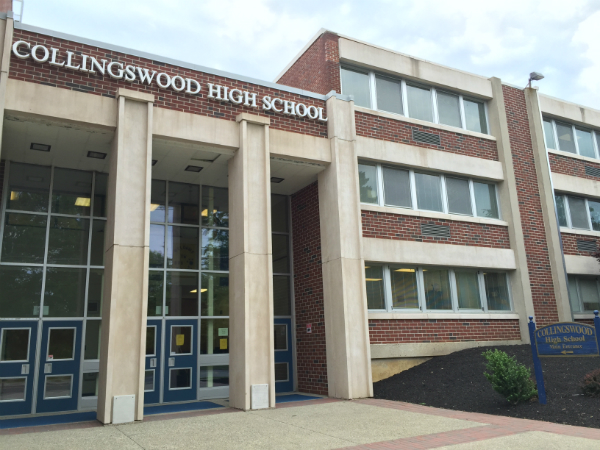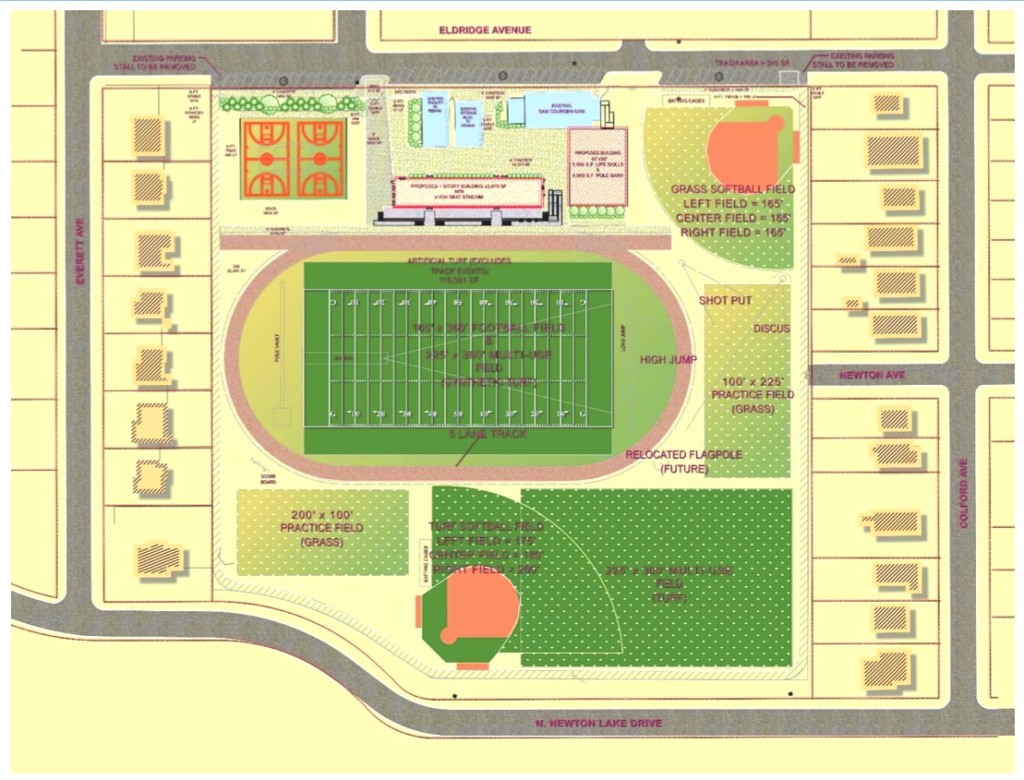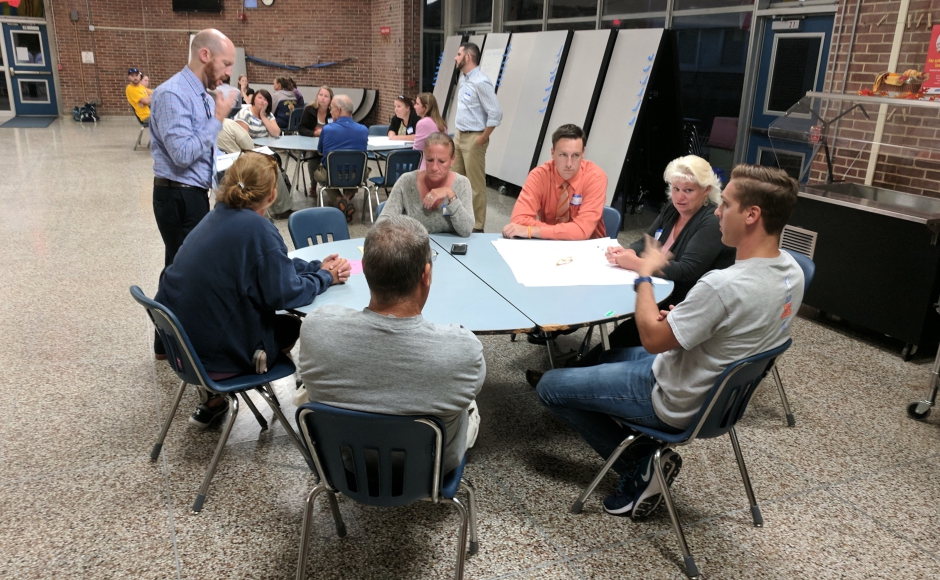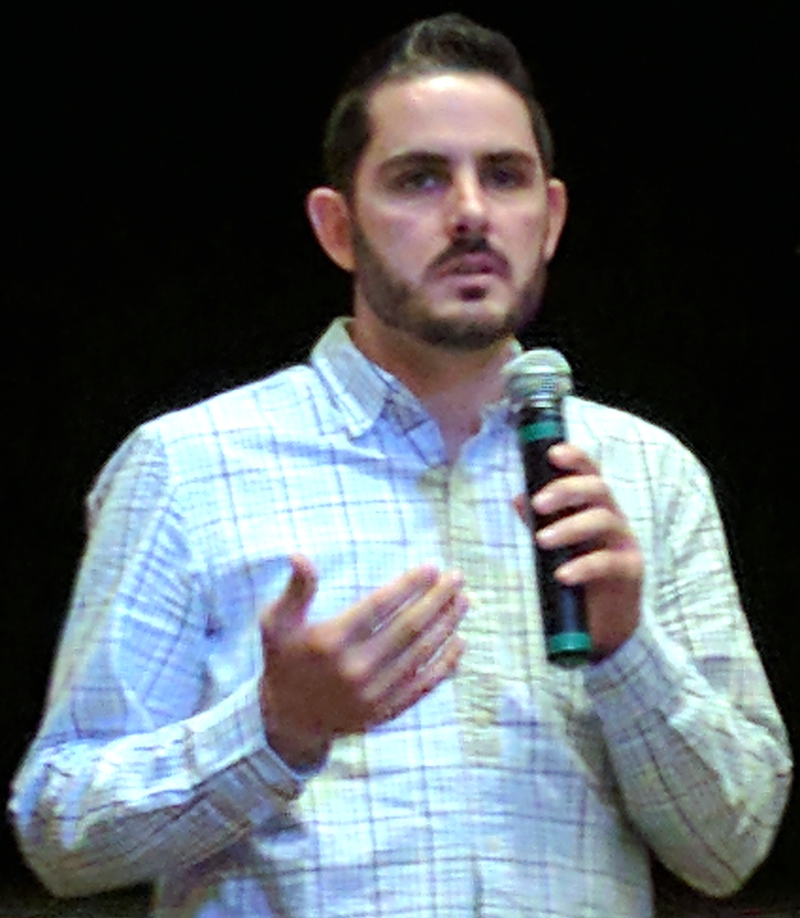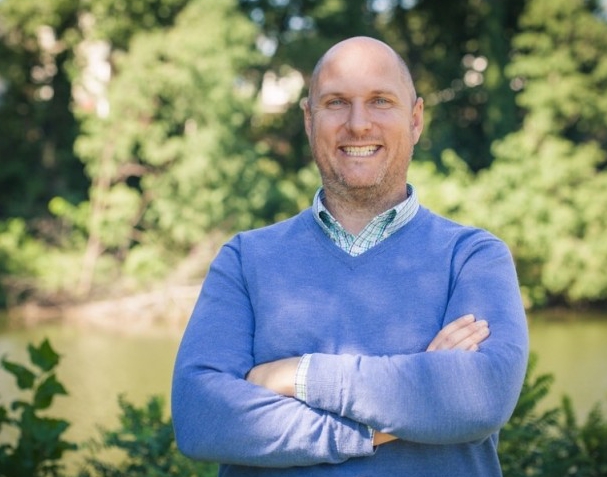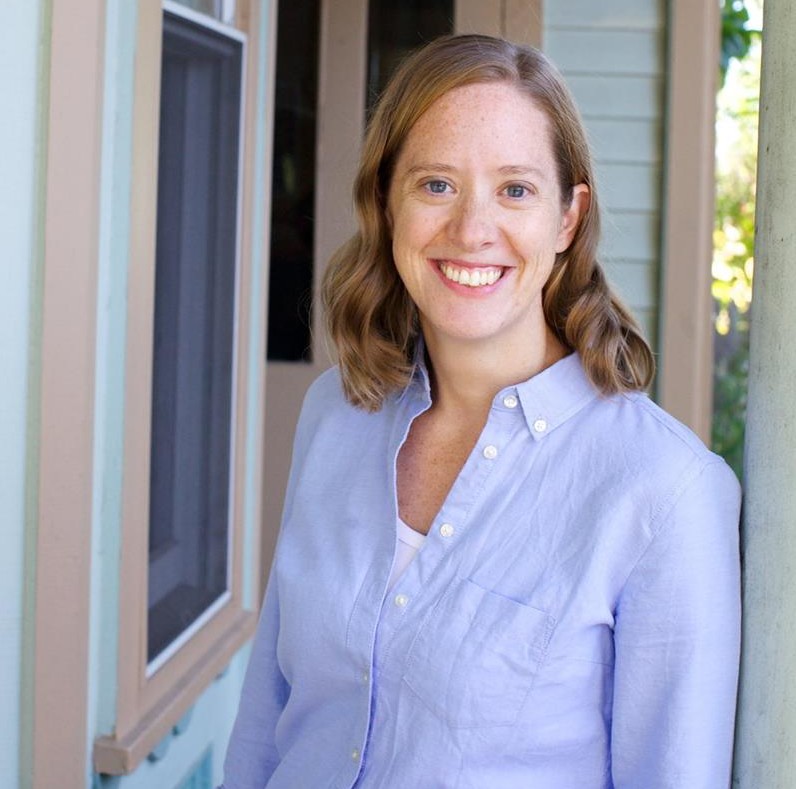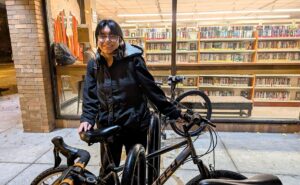The latest version of the district’s athletic facilities renovation plan is the least expensive yet, and a majority of board members want to put it to a public vote. Dissenters worry it won’t pass.
By Matt Skoufalos | November 10, 2017
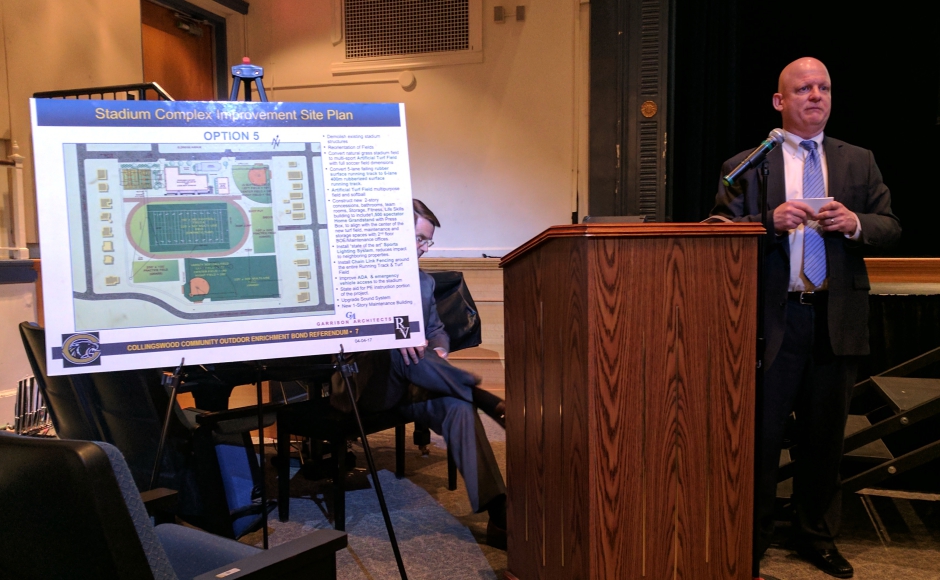
Collingswood BOE President Jim Hatzell presents the plans for the district athletic facilities referendum. Credit: Matt Skoufalos.
The Collingswood Board of Education seems prepared to put its multimillion-dollar athletic facilities renovation project to a public vote.
At its November 6 meeting, seven board members were in favor of a planned March 2018 referendum: President Jim Hatzell, Vice-President Kathleen McCarthy, and Board members Ray Becker, Madalyn Deets, Fiona Henry, and Nina Miller.
Board members Clinton Connor and Jason Waugh were opposed, and Regan Kaiden was undecided. A majority vote at its November 20 meeting will set up a ballot question almost a year after the district introduced its plans to the public.
The current version of the project is a $13.7-million plan that would be more than 95-percent locally funded (after an estimated $664,000 state contribution, the borough would bond $13.044 million), according to Collingswood Superintendent of Schools Scott Oswald.
That results in an estimated average household tax impact of $192 per year for a home assessed at the borough median ($229,150) for the next 20 years.
The latest plan proposes demolishing and reorienting the existing high-school football stadium and converting its playing surface from natural grass to artificial turf.
It also includes:
- a second, multipurpose, artificial turf field
- a six-lane, 400-meter rubberized track surface
- a 1,500-seat home grandstand with a press box, sound and lighting system
- new concession facilities, bathrooms, and team locker rooms
- a life skills classroom for the district’s adult special-needs education program
- a prefabricated metal storage building
This draft retains existing maintenance and storage buildings, but does not include new offices for the Board of Education and district administration, a STEM classroom, or shared community space, all of which had appeared in previous designs. More extensively planned updates to the elementary school playgrounds have been reduced to replacing their current foundations with a poured rubber surface.
“It’s probably the plan that solves most of the problems, going from a five- to a six-lane track, [and the] multi-purpose field on the stadium is wide enough to be regulation [size] for every field sport out there,” Oswald said.
Public feedback on costs, process
The scaled-back proposal cuts another $3.6 million off a plan that had been introduced at $21.8 million in April, and which the board later trimmed to $17.3 million in June.
Residents balked at the initial project cost, offered as the most comprehensive of a range of options that started at $3.98 million.
The tax impact of the project (the Collingswood municipal government is simultaneously seeking to unify its police and fire departments in a new facility) has been cited as a chief complaint, followed closely by questions of process. The plans the district presented in April were generated in steering committees and are rooted in subcommittees of prior boards, but never included a broad public visioning process.
“We started with identifying a need and then reaching out to those most closely aligned to that need,” Oswald said. “We never went out to the full community with a blank slate. I don’t know that the board would or wouldn’t do that. I don’t ever think [the process] was to the exclusion of anyone else.”
Oswald said the project has been discussed at every board meeting in 2017, and that community members “helped give input” that contributed to the different designs, he said.
Nonetheless, as a catch-up mechanism, the district hosted a pair of World Café-style moderated discussions in October, which yielded feedback from 100 community members. Asked to group their comments on the proposal into “positives,” “challenges,” “alternatives,” and “questions,” the bulk of the returns focused on the stadium proposal.
According to a report prepared for the board, 40 of the total comments on the outdoor space were positive remarks, while 63 outlined challenges to the project, 31 suggested alternatives, and nine were categorized as unanswered questions.
Among the positive feedback: turf fields offer “autonomy, increased performance of players, flexibility,” a new stadium “could be seen as a selling point for the town,” and the project yields “more opportunities for community sports programs.”
“Challenges” overwhelmingly cited the cost of the project and what it might mean for other of the district’s budgeting priorities, its impact to neighbors on the surrounding properties, and “health concerns for turf.”
Alternative suggestions included sharing a multi-community field space; building separate, ADA-compliant stands and fixing up the current stadium; or eliminating the stadium altogether.
Positive comments on its proposed interior spaces—a proposed STEM lab, classroom space for the adult special-education program, and the possibility of new revenue derived from it—were balanced with concerns about costs and “incoherent” design elements.
Alternatives and unanswered questions about the indoor project elements included moving the board offices elsewhere within the community, considering a phased referendum to achieve the disparate elements of the plan, and alternative financing models.
Oswald said that feedback informed the revised, $13.7-million plan, but that some of the “great, outside-the-box ideas” it generated—like sharing athletic facilities or adult education programs with neighboring communities—are “not necessarily feasible,” including suggestions to re-bid the project.
“Once a project is underway, I don’t know that we’re ever going to just switch firms,” the superintendent said. “[Haddonfield engineers Remington and Vernick and the Bellmawr-based Garrison architects] have been working together on this project for years,” he said.
The job was bid competitively and the board, which selects its engineers and architects of record annually, has “never experienced an issue” with either vendor, Oswald said.
“Why we would leave an organization that has always been good to us?” he said.
Renovations, referendum on the clock
Board member Jason Waugh said he feels like the district is caught between a plan that it hasn’t had time to vet thoroughly and a dwindling timeline to remedy a long-deferred infrastructure concern.
The current athletic facilities aren’t unsafe, he said, but on a conservative timeline, they could become unusable for a longer period of time than it takes to put a plan in place to fix them.
And if public support for the current plan doesn’t survive a vote, then he worries the district will have doubled down on a failed proposal by adding in another $10,000 to $20,000 in referendum costs.
“[If the vote fails], we’re still left with the crumbling stadium and fields, and the track’s falling apart,” Waugh said.
“We’re banking $10,000 or $20,000 that could be better used. That could be a part-time classroom assistant, two or three [classroom sets of] textbooks.
“I’m in favor of the project, I just don’t think we’re at the point of going out for referendum,” he said. “I’m okay with [the plan] being that much money if we’ve done our due diligence. I just would like some more time.”
Although he believes “the ship for bids from other engineers has sailed,” Waugh said he’d like to open up deeper discussions about alternative fundraising options to lower the cost of the project, from grants to regional corporate sponsorships. How much either of these strategies could reasonably defer from the total cost of the project is difficult to estimate.
Waugh also has practical concerns that all the groups that have been promised access to the facility and its auxiliary fields haven’t been accounted for in the current planning. Furthermore, excluding capital needs from the project, such as the board of education offices, which were cut from the latest draft, doesn’t relieve the district of the need to address those issues.
“If [board offices are] off the table, what’s the alternative for that now?” Waugh said. “We didn’t discuss it. We’re up against the deadline here. I’m not confident to risk $10,000 to $20,000 right now.”
Board member Clinton Connor was the other dissenter in a straw poll taken at the body’s November 6 meeting.
Like Waugh, he fears that bringing an ill-conceived project to a public vote will cost the community more than just lost time.
Subtracting the costs of repairs from its operating budget will mean cuts to programs, staff, and services that could affect the quality of education in the district.
“The costs of services are going up,” he said. “We’re either going to have to cut programs, or we’re going to have to stop fixing things and go out to referendum every couple years.”
Connor said he would like to explore a long-term strategy that involves more creative solutions, including possibly sharing facilities with Oaklyn, with which Collingswood has a send-receive agreement, to add capacity to its athletic program. He also would like to see the district explore more financial options, from grants to fundraising to capital campaigns, but said many of those opportunities evaporate once construction has begun.
“Many grants will have a local match, and you can use the bond to do that, but once you get the project underway, you can’t do that,” Connor said. “Once the process is begun, you can’t dial it back.
“I’d rather spend the next four or five months investigating whether we have viable options that can bring the cost down or create better partnerships with our community partners to create space,” he said.
Connor also has reservations about the wisdom of creating a turf field in a facility that’s used for both graduation and Fourth of July celebrations. Manufacturer’s guidelines caution against using the artificial playing surface for fireworks displays. High-heeled shoes and chair legs may sink into the turf, which means adding a special flooring for graduation ceremonies and ramps for emergency vehicle access.
“It says that there’s a potential that we would have to buy new [football] training equipment because blocking sleds damage the surface,” Connor said. “What’s the maintenance going to be on it?”
“There’s all these questions I have, and I need answers to be able to support the project,” Connor said. “Everybody up there wants the kids to have safe, quality field space, but is this the right way to go about doing it?”
Building consensus
Board member Regan Kaiden worried that putting the question to the public without first generating broader support for the project may doom it.
“I don’t think we did a good job of articulating why this was an important project, and so it feels like now we’re kind of playing catch-up, and that’s a tough place to be,” Kaiden said.
“Are we going to spend this money on a special election that we haven’t done the work to get it to pass?”
At the same time, she said, “there’s literally a net to catch the concrete” at the current high school stadium.
“There’s a reality that things need to get fixed, and trying to put that off to get an ideal plan may not be the most responsible thing to do either,” Kaiden said. “I can vote no on principle, but there is not the will of our board to go back to the drawing board and change things around, unfortunately.”
Collingswood resident Julie Schneider said the revisions to the project have left her confused as to its priorities.
“Can we really wait, or should we just fix what’s really wrong right now?” Schneider said in an e-mail. “Additionally, are the people in the BOE office working in unsafe conditions? This, which was a big concern before, seems to not be a problem anymore. It’s confusing.
“I think it needs to be clear what is real, what is not, and how long do we have.” she wrote. “The rush to vote for this more expensive proposal, rather than one that addresses the problem and is much more affordable, is a little baffling to me.”
Schneider said she’d rather bring the facilities up to standard and direct the school’s focus toward “improving equity” among its neighborhood elementary schools.
Both subjects will be discussed in depth at the meetings of the Collingswood and Oaklyn school boards this month. In addition to tackling the issue of the bond referendum, the Collingswood board will consider moving forward with a plan to expand its send-receive relationship with Oaklyn to include sixth-through-ninth-grade students.
The plan could help both communities “in a time of fiscal uncertainty for small school districts,” Oswald wrote in a November 8 memo. The Oaklyn district meets Tuesday, November 14; the Collingswood Board of Education meets Monday, November 20.
Related Coverage
- Collingswood BOE Preps Athletic Facilities Referendum for Sept. Vote (March 22,2017)
- Collingswood to Consider $20.2M Bond Referendum for School Athletic Facilities (April 6, 2017)
- Collingswood BOE Resets Timeframe for Stadium Bond Referendum, Pares Down Costs (June 12, 2017)
- Collingswood Residents Discuss High-School Stadium Project in Moderated Forums (October 3, 2017)


